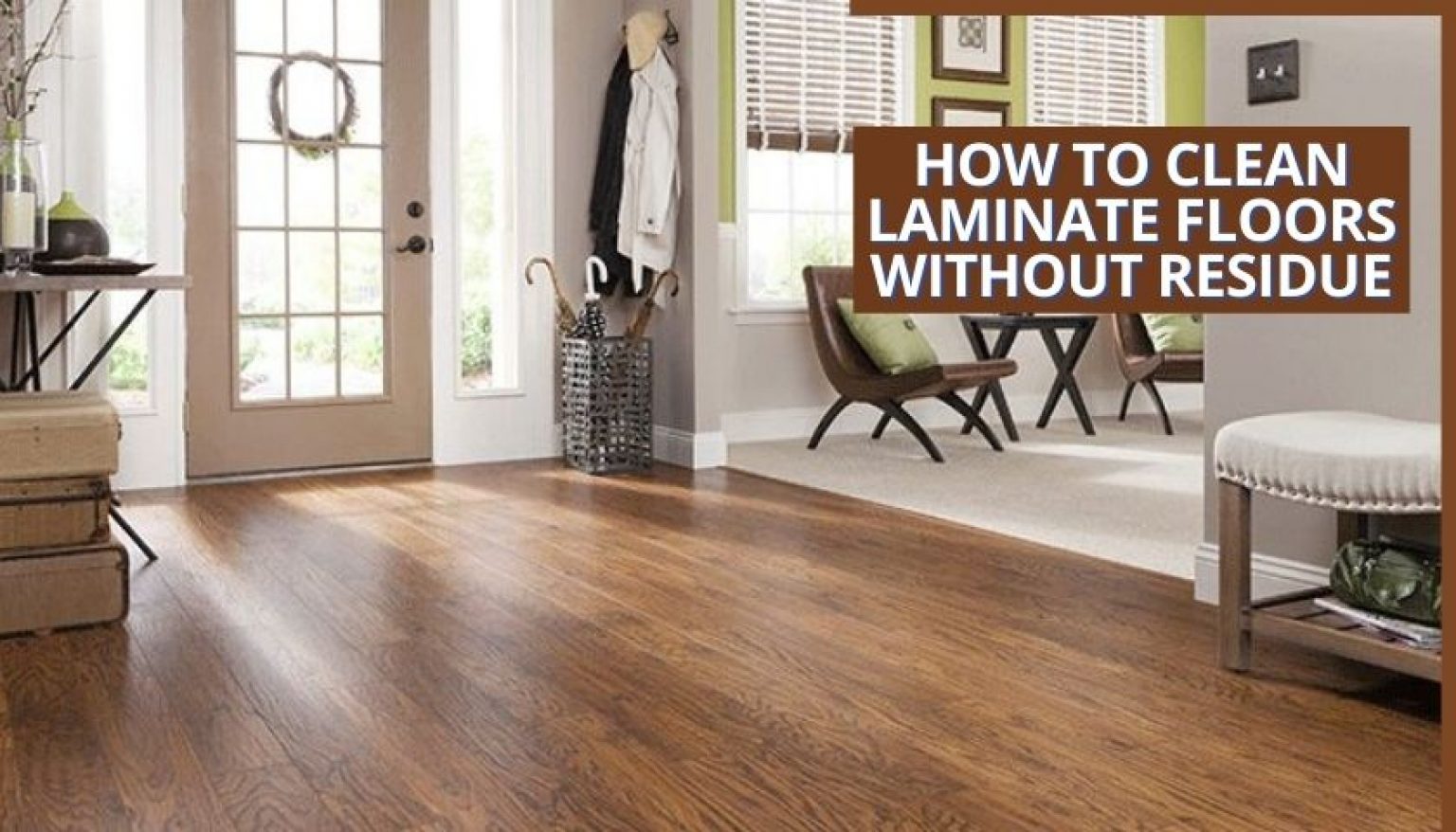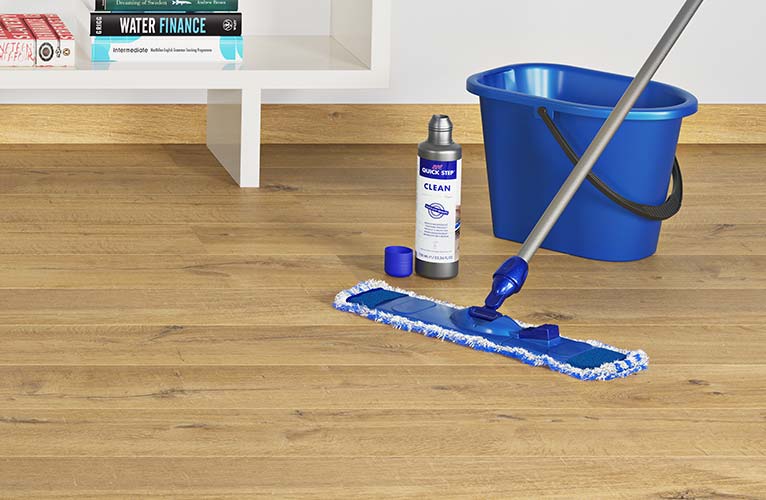Have you ever admired a sparkling clean laminate floor, gleaming with a shine that seems to radiate from within? But then, you try to replicate that look in your own home only to be met with streaks, smudges, and a lingering film that leaves your floor feeling dull and sticky? The quest for a residue-free clean on laminate floors can be a frustrating one, but fear not! This comprehensive guide will equip you with the knowledge and techniques to achieve the pristine look you desire, while respecting the delicate nature of your laminate surface.

Image: www.cleaninginsider.com
Laminate flooring, a popular choice for its durability and affordability, requires a slightly different approach to cleaning compared to other materials. Its smooth surface can easily trap dust, dirt, and spills if the wrong cleaning products or methods are used. The key to a successful and residue-free laminate floor clean lies in understanding the unique challenges associated with this material and adopting a strategic approach that combines effective cleaning agents with proper techniques.
The Importance of a Residue-Free Clean
Why Choose a Residue-Free Cleaning Approach?
A residue-free clean isn’t just about achieving a spotless look. It’s about preserving the longevity and beauty of your laminate floors. When cleaning products or methods leave behind residue, it can lead to several detrimental consequences:
- Dull Appearance: Residue can create a hazy film that dulls the natural shine of your laminate flooring, making it look lifeless and lackluster.
- Increased Wear and Tear: Residue can act like sandpaper, scratching the surface of your laminates over time, making them look worn and aged prematurely.
- Slip and Fall Hazards: Certain cleaning solutions can leave behind a slippery residue, posing a safety hazard, especially for children and elderly individuals.
- Attracts Dust and Debris: Residue can act like a magnet, attracting dust, dirt, and other airborne particles, making your floors appear dirty faster.
Understanding Laminate Flooring and its Cleaning Requirements

Image: www.quick-step.co.nz
The Basics of Laminate Flooring:
Laminate flooring is a popular and versatile flooring option known for its durability and ease of maintenance. It consists of several layers, including a wear layer that protects the design layer beneath it. The wear layer is a key component that determines the durability and scratch resistance of the laminate flooring.
Challenges of Cleaning Laminate Floors:
While laminate flooring is known for its durability and ease of cleaning, there are some challenges to consider:
- Sensitivity to Harsh Chemicals: Certain cleaning agents, like harsh solvents or abrasive cleaners, can damage the wear layer and leave scratches or dullness.
- Water Sensitivity: Excessive water and prolonged exposure to moisture can affect the edges of laminate planks and potentially damage the core.
The Right Approach to Cleaning Laminate Floors
Choosing the Right Cleaning Products:
Selecting the right cleaning products is crucial for a residue-free clean. Avoid using harsh chemicals like bleach, ammonia, or acidic cleaners, as they can damage the laminate surface. Here’s a list of cleaning agents that work well on laminate flooring:
- Mild Dish Soap: It’s a gentle yet effective option for removing dirt and grime without leaving residue.
- White Vinegar: Known for its natural cleaning properties and ability to cut through grease and grime, vinegar also leaves a fresh scent while evaporating quickly.
- Commercial Laminate Floor Cleaners: Look for specifically designed laminate floor cleaners that are non-toxic and residue-free.
The Importance of Diluting:
It’s essential to dilute any cleaning solution you use, whether it’s dish soap, vinegar, or a commercial cleaner. Follow the instructions provided on the product label for safe dilution ratios. A general guideline is to use a mixture of 1/4 cup of cleaner to 1 gallon of warm water. Too much cleaner can leave a residue, especially in areas that are difficult to rinse.
The Power of Microfiber Mopping:
To effectively clean laminate floors without leaving residue, a microfiber mop is a must-have tool. Microfiber cloths are designed to pick up dust and dirt particles without leaving behind lint or fibers. They also absorb moisture readily, helping to prevent water damage. Choose a microfiber mop that has a spritzer bottle attached, allowing you to apply the cleaning solution directly to the floor.
Steps for a Residue-Free Clean:
- Sweep or Vacuum: Remove loose debris and dust by sweeping or vacuuming the floor with a soft-bristled broom or a vacuum cleaner with a brush attachment.
- Prepare Cleaning Solution: Dilute your chosen cleaning solution according to the instructions provided.
- Damp Mop: Dampen the microfiber mop with the cleaning solution, ensuring it’s not dripping wet.
- Mop in Sections: Clean small sections of the floor at a time, working in the direction of the wood grain. Don’t use circular motions, as they can leave streaks.
- Rinse and Dry: After cleaning each section, rinse the mop with plain water and wring out excess moisture. Dry the mopped section with another clean microfiber cloth or a towel.
Additional Tips for a Pristine Finish:
Removing Stubborn Stains:
Tackling stubborn stains requires a slightly different approach. For greasy stains, try a mixture of baking soda and water to create a paste. Let the paste sit on the stain for a few minutes before scrubbing gently with a soft-bristled brush. For water-based stains, a vinegar solution can be effective. Never use harsh chemicals or abrasive cleaners on stubborn stains, as they can damage the laminate surface and leave scratches or dullness. Always test a cleaning solution in an inconspicuous area first to ensure it does not damage the laminate.
Regular Cleaning:
To prevent dirt and debris from accumulating on your laminate floor and making cleaning more difficult, a regular cleaning routine is essential. Sweep or vacuum your floors at least once a week and mop them with a diluted cleaning solution every two weeks.
Protecting Your Laminate Floors:
Following proper cleaning practices will help extend the life of your laminate floors, but there are additional steps you can take to protect them: Use protective mats at entryways to prevent dirt and debris from being tracked in. Place furniture pads under heavy objects to prevent scratches and indentations. Avoid walking on your laminate floors with shoes that have harsh soles or high heels.
How To Clean Laminate Floors Without Residue
Conclusion:
Achieving a residue-free clean on your laminate floors starts with understanding the delicate nature of the material and using the right cleaning products and techniques.
This guide equips you with the knowledge and practical steps to ensure your laminate flooring remains clean, pristine, and beautiful for years to come. Remember, a residue-free clean not only enhances the appearance of your flooring, but also protects it from damage and premature wear and tear. By following these tips and maintaining a regular cleaning routine, you can enjoy the beauty and practicality of your laminate flooring for a long time to come.






